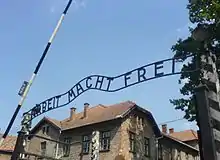Aid and Rescue Committee
The Aid and Rescue Committee, or Va'adat Ha-Ezrah ve-ha-Hatzalah be-Budapesht (Vaada for short; name in Hebrew: ועדת העזרה וההצלה בבודפשט) was a small committee of Zionists in Budapest, Hungary, in 1944–1945, who helped Hungarian Jews escape the Holocaust during the German occupation of that country.[1] The Committee was also known as the Rescue and Relief Committee, and the Budapest Rescue Committee.
| Part of a series of articles on the Holocaust |
| Blood for goods |
|---|
 |
The main personalities of the Vaada were Ottó Komoly, president; Rudolf Kasztner, executive vice-president; Samuel Springmann, treasurer; and Joel Brand, who was in charge of tijul or the underground rescue of Jews.[2] Other members were Hansi Brand (Joel Brand's wife); Erno Szilagyi from the left-wing Hashomer Hatzair.[3] ;Peretz Revesz Andras Biss and Nison Kahan. After the German occupation in March 1944 responsibilities were split: Otto Komoly became mainly in charge of dealing with Hungarian government, military and police figures (the so-called 'line A'), while Kasztner (after Brand's departure to Istanbul) led the negotiations with the Germans (the so-called 'line B') including Eichmann.
References
- Bauer, Yehuda (1994). Jews for Sale: Nazi–Jewish Negotiations, 1933-1945. New Haven: Yale University Press, p. 152. ISBN 978-0300059137
- Hilberg, Raul. The Destruction of the European Jews, Yale University Press, 2003, p. 901.
- Bauer 1994, p. 153.
Further reading
- Szita, Szabolcs (2005). Trading in Lives? Operations of the Jewish Relief and Rescue Committee in Budapest, 1944–1945. Budapest and New York: Central European University Press. ISBN 963-7326-30-8.
- Braham, Randolph L. , The politics of genocide : the holocaust in Hungary
- Molnár, Judit: Otto Komoly Diary
- Weitz, Y (2011) The Man Who Was Murdered Twice: The Life, Trial and Death of Israel Kasztner, Jerusalem: Yad Vashem.